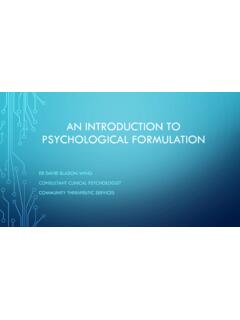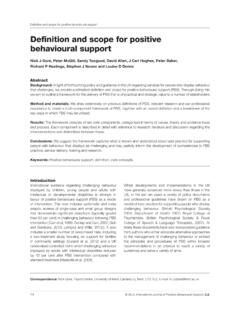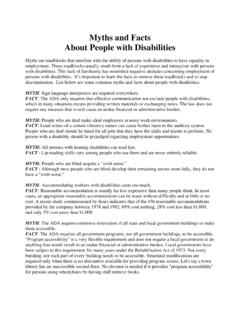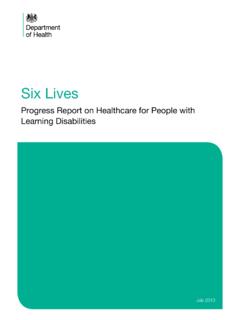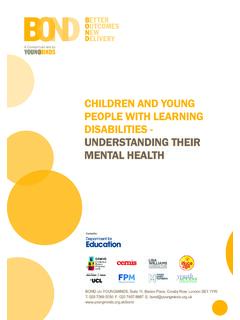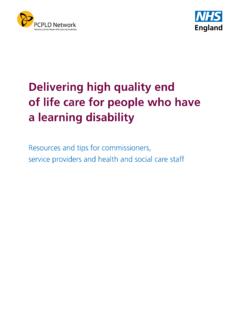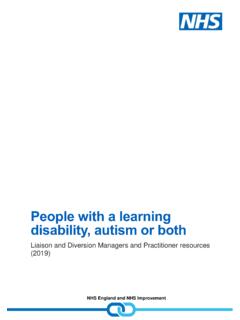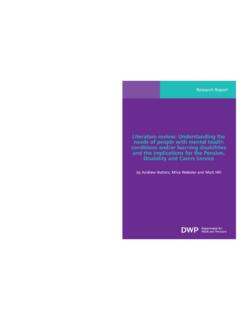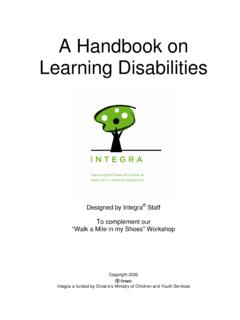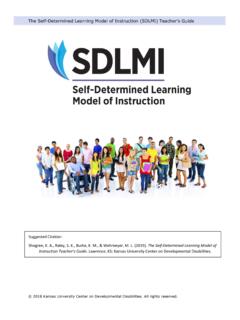Transcription of COVID-19: Activity Ideas for people with learning ...
1 learning disabilities Professional Senate: 20th April 2020 1 learning Disability Professional Senate COVID-19: Activity Ideas for people with learning disabilities in in-patent units whilst in isolation Introduction The learning disabilities Professional Senate has put together this guidance that may be useful to support people with learning disabilities who are in in-patient units during the coronavirus restrictions. The material contained in this resource has been developed by individuals or organisations and we have acknowledged these wherever possible. We thank everyone for their swift response in developing information. The learning disabilities Professional Senate does not accept responsibility for any of the information in this guidance, but hope that they are useful in supporting people with learning disabilities and families and carers who support them.
2 Different Ideas may be more appropriate for different people , and we are not recommending any specific strategies. Please look through all the Ideas and choose the ones that are appropriate for your situation. The guidance in the attached documents is valid at the time that they are developed, but may need amending as government action changes. Please keep safe Karen Dodd Co-Chair LD Professional Senate learning disabilities Professional Senate: 20th April 2020 2 Contents: Social distancing and isolation Page 3 Top Tips to keep well Page 4 Setting goals Page 6 Keeping in touch Page 7 Making a sensory kit Page 8 Sensory Art Ideas : Shaving Foam Marbling Page 10 Sensory Art Ideas : Puffy Paint Page 11 Making cards Page 12 Things to grow: Bottle herb garden Page 13 Things to grow: Grass Head Page 14 Ideas to get moving Page 16 Music and singing Page 20 Ideas for a good night s sleep Page 21 Goal setting sheet Page 22 learning disabilities Professional Senate.
3 20th April 2020 3 Social distancing Because of corona virus we are all having to change the way we do things: We can only see people that we really need to see. When we do see people we have to keep further apart We have to stay indoors more to stop people catching and spreading the virus. We can only go out for very important things like health appointments, to get food and shopping and to do our daily exercise. This is called social distancing and everyone has to do this. Self isolating If you have any signs or symptoms of coronavirus, or have been in touch with some one who does you need to self-isolate. This means that you have to stay indoors and not go out. You can go in the garden if there is one. You can t have any visitors for either 1 week or two weeks depends on if you have felt unwell or someone else has.
4 These new rules mean that our usual routines are harder to follow. It means that some of the roles we have and the activities we enjoy have had to be put on hold for a while. Doing things we like and enjoy is important to keep us feeling good about ourselves. Even if we can t do the things we usually enjoy, we might be able to organise our day and do other things that we can enjoy. Here are some Ideas and some activities that you can do whilst we are all isolating because of corona virus. learning disabilities Professional Senate: 20th April 2020 4 Top Tips to keep well 1. have a routine: Get up at the same time each day, get yourself washed and dressed, have your breakfast, do what you normally would to get ready for the day. 2. Balance out the jobs you have to do, like tidying and cleaning, with activities that you like to do, like watching a film, or doing a puzzle 3.
5 Think about what activities are most important to you and how you can carry on doing those. You might need to change things around a little bit to do them. For example, instead of going out for a pizza you could make one with one of the staff. 4. Set yourself a goal each day and tick it off when it s done. You might write 7 goals out for the week, or one each day. They might be to try new things, to get jobs done that you haven t got around to yet, whatever you want them to be. 5. Talk with staff about what might make you feel sad, upset or frustrated about the changes. Make a plan of what you can do if you do feel sad, upset or frustrated. learning disabilities Professional Senate: 20th April 2020 5 6. When you can t see the people that are important to you, you can try new ways to talk to them.
6 You can use the phone, video call, or try a group video call so you can talk to more than one person at once. 7. Take care of yourself. Eat well, have fruit and vegetables and drink water to keep you hydrated. 8. Do things that get you moving about. Try not to sit in the same position for too long. Get up and move around 9. Get a good night s sleep. Go to bed at the same time you usually do. Having a bath, listening to gentle music and deep breathing can help you to relax, ready for a good night s sleep. 10. Talk to people . Let them know how you are feeling. Share Ideas and tell stories. Keep in touch. Adapted from: Staying Well when Social Distancing, The Royal College of Occupational Therapists, 2020 learning disabilities Professional Senate: 20th April 2020 6 Setting goals A goal is something that you want and plan to do.
7 When things change, like they have now, it is easy to lose routine and motivation. Having a goal keeps us focussed and helps us to achieve things. Good goals are things we can do. Good goals make us feel happy when we have achieved them. When you set a goal you have to think about: 1. What do you want to achieve? 2. Why do you want to achieve it? 3. How are you going to do it? 4. When are you going to do it? 5. How will you know you have done it? It s good to write your goal down, and write down how and when you plan to achieve it. This way you know what your plan is and you can then work on meeting your goal. You might be able to set some goals from the Ideas you see in this guide: You might have a goal to try a new Activity . You might have a goal to make a card for someone you can t see at the moment. You might have a goal to make a sensory kit to give you more energy to start your day.
8 There is a goal sheet at the end of this guide that you can print and fill out. learning disabilities Professional Senate: 20th April 2020 7 Keeping in touch The new rules mean that we can t see people as much. Not being able to see our families and friends can be hard. We will miss them. There are different ways you can keep in touch if you can t see people face to face. You can try Video calling Writing a letter Keeping a diary so you can remember what s happened and talk about it when you can see your family and friends again You can keep a photo diary or a video diary on your phone You can draw pictures learning disabilities Professional Senate: 20th April 2020 8 Making a sensory kit We get sensory information from all around us: what we hear, what we see, what we smell, what we taste, what we feel on our body, how we feel inside our body and how we move around.
9 Some sensory information helps us feel relaxed, some helps us feel excited, some helps us feel calm, some helps us get up and get going, some helps us to take our minds off things. You can make a sensory kit to help you do any of those things. What will you call your sensory kit? Where will you keep your sensory kit? Can you keep it in your room? Will staff need to keep it for you? How will staff know you want it? How will you use your sensory kit? When will you know to get your sensory kit out? Do you need to be in a particular place to use it? Will you use it on your own or with someone else? Will you use it at the same time each day or will it be when you feel like it? What will be in your sensory kit? Think about the tastes, sights, sounds, touch and smells you need to make your sensory kit work for you Things that make you feel calm: Warm shower Warm bath Wrapping yourself up Rubbing creams into your skin Big stretches, like yoga Slow music with a good rhythm The sounds of nature Natural smells Soft materials Laying on soft surfaces, like a squashy mattress or a beanbag Being in a rocking chair or on a swing Low lighting Sucking sweets Chewing gum Humming Gentle walks Things that wake you up.
10 Cool shower Cool bath Being in a cold room Tickling the back of your hands or the inside of your arms Jumping up and down Dancing to fast music Singing loudly or karaoke Spinning round Bright lights Flashing lights Drinks with strong flavours like coffee Eating an ice pop or a lolly Eating spicy foods Walking fast or running Playing with a spiky ball Rubbing your hands over rough materials like velcro learning disabilities Professional Senate: 20th April 2020 9 Everyone is different, so try things out and see what works for you. Your sensory kit might be a box that you have decorated that has things inside. It might have some bubbles, a soft cushion and some dried lavender that you use when you are laying on your bed to help you relax. Your sensory kit might be a list of things that you do. It might say do the Joe Wicks workout on YouTube, sing your favourite song and put your after shave on.



